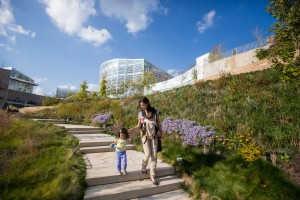February 26, 2021
By Tamanna Mohapatra

Phipps Center for Sustainable Landscapes
At what cost are we willing to work in buildings that don’t prioritize our well-being? This may well be a question we no longer need to worry about. This past January, we got some good news about the launch of
IWBI’s new Health Safety-Seal that could improve health and safety in your neighborhood as soon as this year. Your bakery, your office and your childcare center (even your local nail parlor!) could decide to pursue the WELL Health Safety rating.
IWBI, the company behind the WELL rating, earlier provided a list of measures that employers could implement in their buildings to improve the health and well-being of their employees. Think better lighting, optimal air quality, easier access to water fountains and more. In fact, WELL is the first building standard to focus exclusively on the connection between human health, well-being, and the built environment, plus it’s designed to complement the
U.S. Green Building Council’s LEED certification system. Since most employees worked from home this past year, one could have assumed a WELL rating was the last thing on an employer’s mind. The reality is very much the opposite. WELL has never been more relevant, nor IWBI busier.
The Health Safety Rating We’ve Been Waiting For
COVID-19 was the catalyst to take WELL to the next level. After working with experts from around the world to prepare our physical spaces for re-entry in a post-COVID-19 environment, IWBI developed a solution to address the unique health issues created by the pandemic. In a record three months, they launched a new WELL Health Safety Rating for Facility Operations & Management, which is both a stand-alone offering and a part of the overall WELL certification.
The core product remains the WELL Building Standard, which is focused on design, operations, and policy strategies for the built environment. The WELL Health-Safety Rating is rooted in the WELL building standard and made up of a subset of features aimed at reducing the risk of transmission and addressing the threat of other issues in the environment. It’s designed to prepare for the emergencies of today and tomorrow, as well as protect air and water quality. The features included in the health rating are verified on a near-monthly basis. Its popularity can be attributed to being flexible (applicable to all space types), verified, scalable, and accessible (no capital expenditure).
IWBI’s work transcends borders, with the WELL Building Standard™ (WELL) continuing to spread around the world. The WELL movement ended the year 2020 with 1.5 billion + square feet of work spread over 13,250+ projects across 82 countries. Their growing success is easy to understand as health is a priority everywhere.
All Building Types Are Created Equal
In the U.S., most projects are tenant-driven and include schools, airports, and commercial real estate. In China, the projects include multi-family and residential units. The goal behind the new Health Safety rating is to revitalize all building types, so that every occupant feels safe, healthy, and ultimately thrives. Indeed, flexibility is a key advantage and aspect of this rating. Offices, stadiums, hotels, and schools are some leading examples. Some early adopters include JP Morgan Chase, Yankee Stadium, Wyndham Hotels, and our very own Empire State Building. While the current WELL Building Standard v1 is optimized for commercial and institutional buildings, pilot programs are now available in retail, multi-family, residential, education, restaurant, and commercial kitchen projects.
Let’s Get Down to Details
The COVID-19 task force created by IWBI looked at necessary safety aspects of a building and came up with 15 required features across
6 different categories that included Cleaning & Sanitization Procedures, Emergency Preparedness Programs, Air & Water Quality Management and others. Some of the key features of the new Safety rating include improving cleaning practices, supporting mental health, providing ample sick leave, promoting the flu vaccine, and important measures such as frequent and proper handwashing. As of early January 2021, there were 6750+ assets who had achieved this rating and were ready to be reopened, easing their own minds and those of their occupants.
Star-Studded Endorsements

This past January, IWBI launched a marketing campaign involving celebrity endorsements for their WELL Seal. With this seal, WELL hopes to start the journey from exclusive to mainstream and become a symbol of consistency, health, and confidence.
Join the Movement
If you’re interested in getting involved, explore the WELL AP (Accredited Professional) Certification. There are more than 16,000 registered WELL APs across 98 countries, and due to the pandemic, the certification is now being offered at a substantial discount. Check out these resources:
https://www.wellcertified.com/health-safety/
Wellhealthsafety.com
wellcertified.com/health-safety/directory
References for article: WELL Connect
Zoom call that took place on 1/19/2021
To learn more,
attend our upcoming March Forum where we will have a speaker from WELL.
 This past January, IWBI launched a marketing campaign involving celebrity endorsements for their WELL Seal. With this seal, WELL hopes to start the journey from exclusive to mainstream and become a symbol of consistency, health, and confidence.
Join the Movement
If you’re interested in getting involved, explore the WELL AP (Accredited Professional) Certification. There are more than 16,000 registered WELL APs across 98 countries, and due to the pandemic, the certification is now being offered at a substantial discount. Check out these resources:
https://www.wellcertified.com/health-safety/
Wellhealthsafety.com
wellcertified.com/health-safety/directory
References for article: WELL Connect Zoom call that took place on 1/19/2021
To learn more, attend our upcoming March Forum where we will have a speaker from WELL.
This past January, IWBI launched a marketing campaign involving celebrity endorsements for their WELL Seal. With this seal, WELL hopes to start the journey from exclusive to mainstream and become a symbol of consistency, health, and confidence.
Join the Movement
If you’re interested in getting involved, explore the WELL AP (Accredited Professional) Certification. There are more than 16,000 registered WELL APs across 98 countries, and due to the pandemic, the certification is now being offered at a substantial discount. Check out these resources:
https://www.wellcertified.com/health-safety/
Wellhealthsafety.com
wellcertified.com/health-safety/directory
References for article: WELL Connect Zoom call that took place on 1/19/2021
To learn more, attend our upcoming March Forum where we will have a speaker from WELL.

